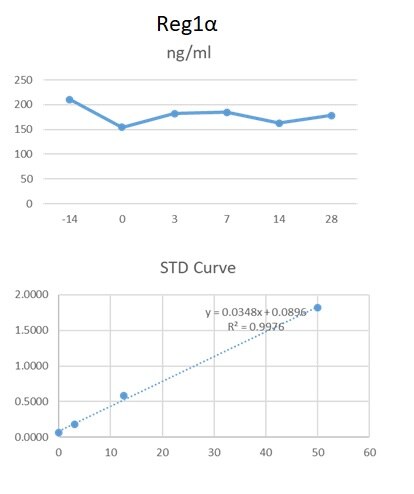Human Reg1A/B Antibody Summary
Gln23-Asn166
Accession # P05451
Applications
Please Note: Optimal dilutions should be determined by each laboratory for each application. General Protocols are available in the Technical Information section on our website.
Scientific Data
 View Larger
View Larger
Detection of Human Reg1A by Western Blot. Western blot shows lysates of human pancreas tissue. PVDF membrane was probed with 1 µg/mL of Sheep Anti-Human Reg1A Antigen Affinity-purified Polyclonal Antibody (Catalog # AF4937) followed by HRP-conjugated Anti-Sheep IgG Secondary Antibody (Catalog # HAF016). Specific bands were detected for Reg1A at approximately 20-22 kDa (as indicated). This experiment was conducted under reducing conditions and using Immunoblot Buffer Group 1.
 View Larger
View Larger
Reg1A in Human Pancreas. Reg1A was detected in immersion fixed paraffin-embedded sections of human pancreas using Sheep Anti-Human Reg1A Antigen Affinity-purified Polyclonal Antibody (Catalog # AF4937) at 3 µg/mL overnight at 4 °C. Before incubation with the primary antibody, tissue was subjected to heat-induced epitope retrieval using Antigen Retrieval Reagent-Basic (Catalog # CTS013). Tissue was stained using the Anti-Sheep HRP-DAB Cell & Tissue Staining Kit (brown; Catalog # CTS019) and counterstained with hematoxylin (blue). Specific staining was localized to cytoplasm in exocrine cells. View our protocol for Chromogenic IHC Staining of Paraffin-embedded Tissue Sections.
Reconstitution Calculator
Preparation and Storage
- 12 months from date of receipt, -20 to -70 °C as supplied.
- 1 month, 2 to 8 °C under sterile conditions after reconstitution.
- 6 months, -20 to -70 °C under sterile conditions after reconstitution.
Background: Reg1A/B
Reg1A (Regenerating gene IA/ alpha ; also REG, ICRF, PSPS, PTP and Lithostathine-1 alpha ) is a secreted, variably glycosylated 15-22 kDa type I member of the REG gene family of proteins. It is induced in proliferating cell types such as colonic epithelium, islet beta -cells, and multiple tumor types, and is constitutively expressed by pancreatic acinar cells. Thus, Reg1A is found both in blood (ng/mL quantities) and pancreatic secretions. It would appear that Reg1A plays a role in blocking apoptosis, and is upregulated by both IL-22 and IL-6. Human Reg1A is synthesized as a 166 amino acid (aa) precursor. It contains a 22 aa signal sequence plus a 144 aa mature region that is characterized by the presence of three intrachain disulfide bonds, one C-type lectin domain (aa 34-164), and a utilized N-terminal O-linked glycosylation site (Thr27). Variablility in the glycosylation pattern, plus proteolytic cleavage after Arg11 generates Reg1A isoforms in the 15-22 kDa range. There is one potential isoform variant that shows an alternative start site at Met9. Mature (aa 23-166) human Reg1A shares 76% and 69% aa sequence identity with mouse and rat Reg1A, respectively.
Reg1B, also known as secretory pancreatic stone protein 2 and lithostathine 1 beta, is a type I subclass member of the Reg family, which comprises secreted proteins with a C-type lectin domain. Reg1B is highly related to Reg1A, a protein that is implicated in islet cell regeneration and diabetogenesis.Product Datasheets
FAQs
No product specific FAQs exist for this product, however you may
View all Antibody FAQsReviews for Human Reg1A/B Antibody
Average Rating: 4 (Based on 1 Review)
Have you used Human Reg1A/B Antibody?
Submit a review and receive an Amazon gift card.
$25/€18/£15/$25CAN/¥75 Yuan/¥2500 Yen for a review with an image
$10/€7/£6/$10 CAD/¥70 Yuan/¥1110 Yen for a review without an image
Filter by:
We used this antibody in an in-house ELISA along with mAb (49371) and protein standard to quantify Reg1 alpha in human serum and plasma. This combination detected Reg1alpha in human serum and plasma.

